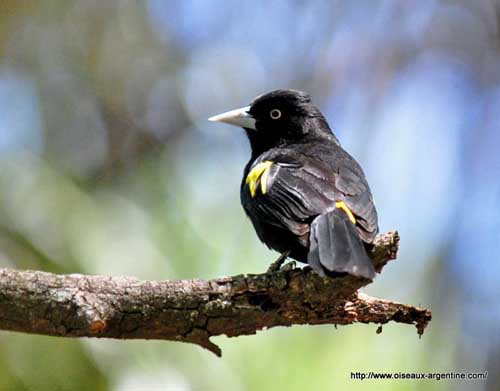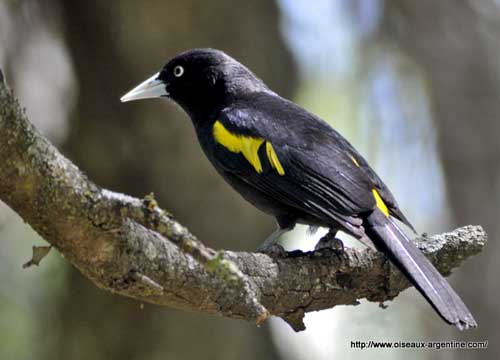
Fr: Cassique à epaulettes
All : Goldschulterkassike
Esp: Arrendajo de Alas Doradas
Ital : Cacico alidorate
Nd: Goudvleugelbuidelspreeuw
Sd: Mindre kasik
Port: Tecelão
Photographers:
Philippe et Aline Wolfer
GALERIE
Text by Nicole Bouglouan
Sources:
HANDBOOK OF THE BIRDS OF THE WORLD Vol 16 by Josep del Hoyo- Andrew Elliot-David Christie – Lynx Edicions – ISBN: 9788496553781
NEW WORLD BLACKBIRDS – THE ICTERIDS by Alvaro Jaramillo and Peter Burke – Helm - ISBN : 0713643331
BirdLife International (BirdLife International)
Neotropical Birds – Cornell Lab of Ornithology
Golden-winged Cacique
Cacicus chrysopterus
Passeriforme Order – Icteridae Family
BIOMETRICS:
Length: M: 20-21 cm – F: 19 cm
Weight: M: 34-47 g – F: 30-34 g
DESCRIPTION:
The Golden-winged Cacique is a South American species apparently sedentary in its range.
The adult has black, slightly glossy plumage overall, except the bright yellow band on lower rump, and the wing patches. Medians and inner greater upperwing-coverts are bright yellow, forming conspicuous wing patch. However, it can be sometimes hidden by the scapulars.
The strong conical bill is pale bluish-grey. The eyes may vary from orange to yellow and from pearly white to pale blue. Legs and feet are black.

The female has similar plumage but she is slightly smaller than male.
The juvenile is duller, more blackish-brown than black. The eyes are dark and the bill is usually darker than on adults.
VOICE: SOUNDS BY XENO-CANTO
The Golden-winged Cacique utters an ascending, nasal “aa-ah” as contact call, and a common mewing “charr” or “wreyur”.
The song is variable but rather musical, a loud series of notes slowly delivered with a final, loud burst which is the only part heard from a distance. The entire song may sound like “cuuk-kaa-Prrrr-WHIIP-WHEEEO” with some variants because notes and pitches are varied. This species may sometimes mimic other birds’ species.
Pairs may perform duets to communicate. Each mate utters a slightly different song in response to the one given by its partner.
HABITAT:
The Golden-winged Cacique frequents forests and forest edges, but avoids the lowland rainforest. It can be found from moist mountain forests on humid Andean slopes, to dry gallery woodland in the drier parts of the range.
It favours second growths and open forests, as well along streams as roads.
This species can be seen up to 2800 metres of elevation in the Andes.
RANGE:
The Golden-winged Cacique is found in E Bolivia and S Brazil, southwards to N Argentina and NW Uruguay.
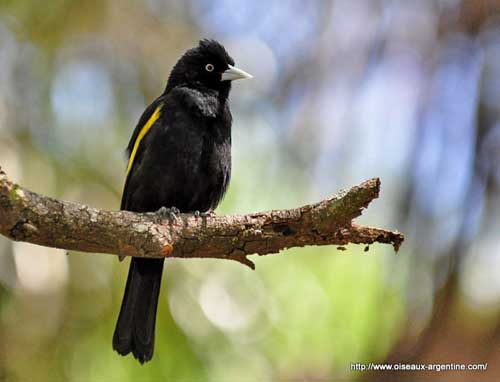
BEHAVIOUR:
The Golden-winged Cacique feeds on various invertebrates including insects, also small vertebrates, fruits and nectar from flowers. It often probes into bark crevices and opens hollow twigs. It is able to hang upside-down when foraging, usually in the middle strata but not in the canopy.
It is often seen in pairs or family groups, but it is usually alone and rarely in flocks. This species is mostly arboreal and feed in trees on fruits and insects, but it may sometimes come to the ground.
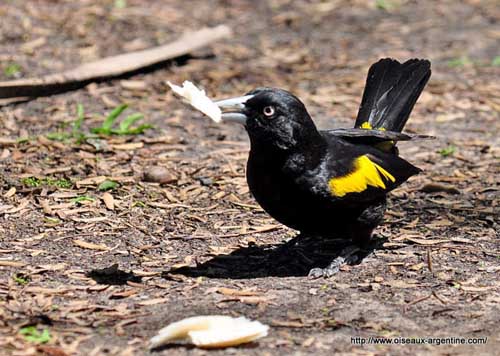
During the breeding season, the male sings around the nest-site and performs some displays. This species is monogamous and solitary nester and builds a pensile nest.
The courtship displays are poorly known, but the contrasted black and yellow plumage pattern is probably enhanced by the typical Icteridae display named “Song-Spread”.
The male perches with lowered head, raised body and crest feathers, open wings and fanned tail, in order to expose the bright yellow patches of rump and wings. These displays are accompanied by song.
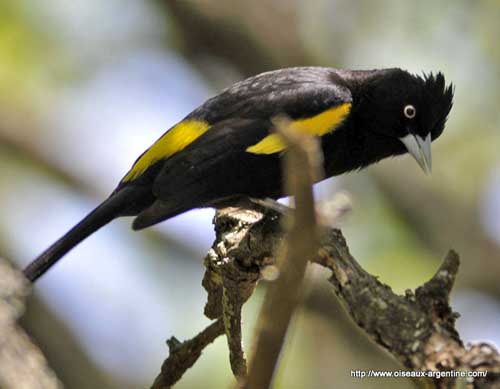
The Golden-winged Cacique is mainly sedentary in its range. Some altitudinal movements are reported in the mountains of NW Argentina and Bolivia.
FLIGHT:
The Golden-winged Cacique has an agile flight during which the black and yellow plumage is conspicuous.
REPRODUCTION:
In Argentina, the breeding season occurs between October and December. The Golden-winged Cacique is solitary nester and monogamous.
The nest is a hanging basket of 60/100 cm in length. This long purse is suspended from the end of an isolated branch, often over water, stream or pond.
It is made with woven thin blackish fibres, sometimes mixed with horse hair. This nest is usually placed less than five metres above the ground.
The Golden-winged Cacique’s nest is often parasitized by the Shiny Cowbird.
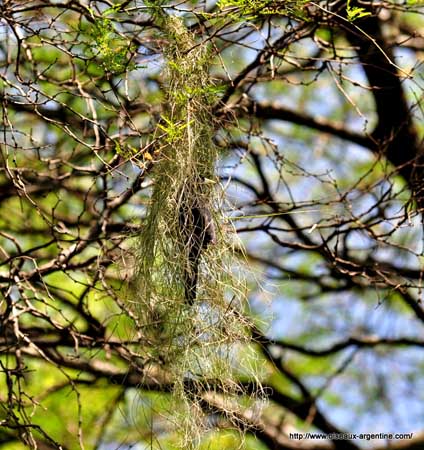
The female lays 2-4 white eggs with brownish spots. She incubates alone during about two weeks. Both adults feed the chicks which fledge 18-19 days after hatching. Fecal sacs are regularly removed by the parents.
They remain in family groups for some months.
DIET:
The Golden-winged Cacique feeds on insects such as Coleoptera and Lepidopteran caterpillars, and other invertebrates. It also takes small vertebrates, various fruits species including wild and cultivated fruits, and feeds on nectar from flowers such as Bromelia, Aechmea and Fuchsia.
PROTECTION / THREATS / STATUS:
The Golden-winged Cacique is fairly abundant in suitable habitat such as forest and woodland, and rare or local in drier regions of the range. It occurs in several protected areas.
This species is not currently threatened.
